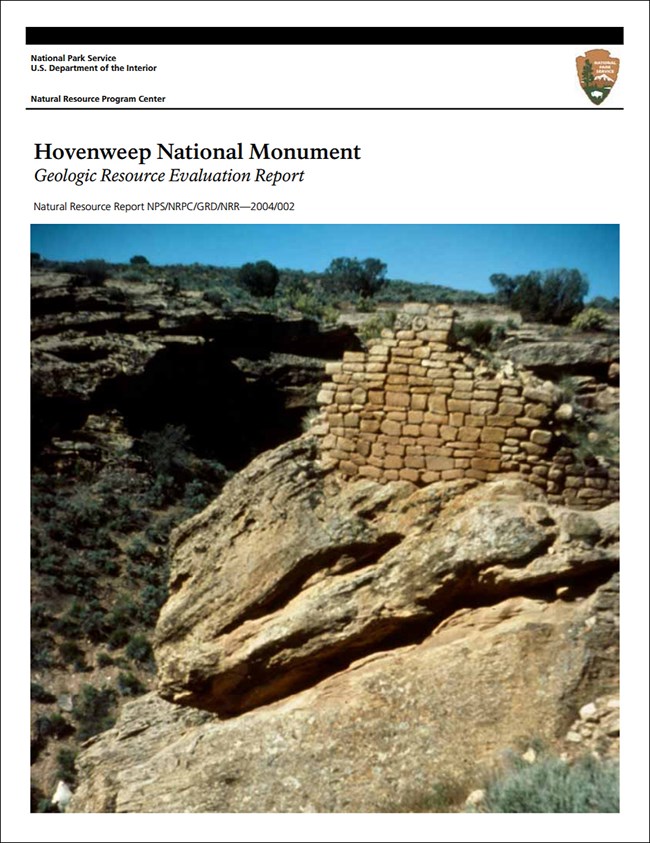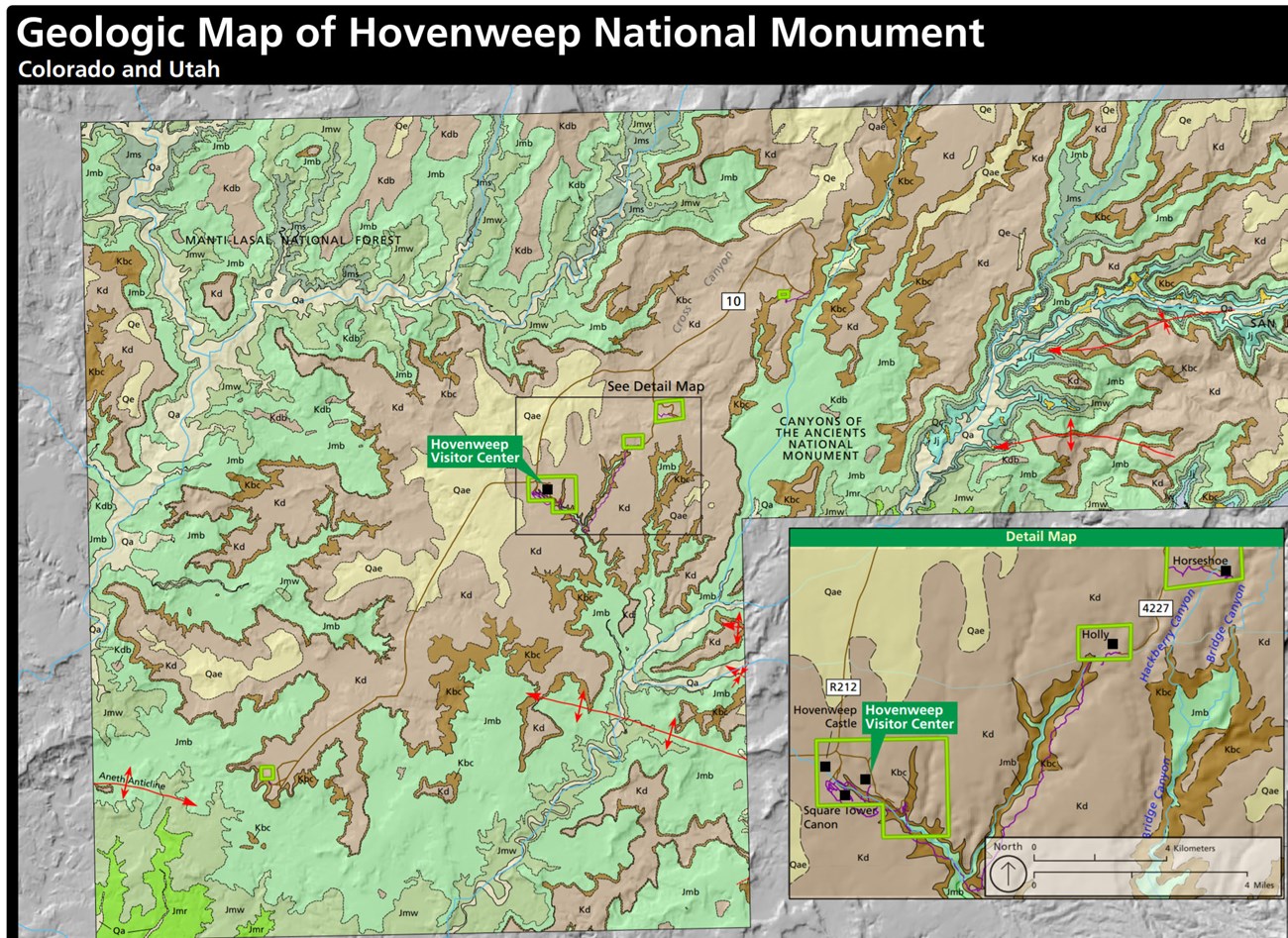Last updated: July 8, 2024
Article
NPS Geodiversity Atlas—Hovenweep National Monument, Colorado and Utah
Geodiversity refers to the full variety of natural geologic (rocks, minerals, sediments, fossils, landforms, and physical processes) and soil resources and processes that occur in the park. A product of the Geologic Resources Inventory, the NPS Geodiversity Atlas delivers information in support of education, Geoconservation, and integrated management of living (biotic) and non-living (abiotic) components of the ecosystem.

Introduction
Hovenweep National Monument (HOVE) is located along the Colorado–Utah border and is made up of several units located in Montezuma County, Colorado and San Juan County, Utah. The monument headquarters are approximately 40 km (25 mi) north of the Four Corners of Colorado, Utah, Arizona, and New Mexico. HOVE encompasses 318 hectares (785 acres) and was established March 2, 1923 to preserve the archaeological treasures left by the Ancestral Puebloan (formerly known as Anasazi) civilization. The monument includes six prehistoric villages built between A.D. 1200 and 1300 that include multi-story towers, castles, pueblos, and cliff dwellings that are spread over 42 km (26 mi) (Anderson 2017). The canyons, dwellings, dams, ledges, and assorted relics of HOVE have inspired wonder in visitors to the sites.
Geologic Setting
The geology of Hovenweep National Monument consists primarily of exposures that are Jurassic or Cretaceous in age. Knowing the geology of the monument is fundamental in understanding the relationship between ancient cultures and the desert landscape. One particular geologic unit of HOVE, the Cretaceous Naturita Formation (formerly the Dakota Sandstone), was a fundamental resource of the Ancestral Puebloans. Seeps and springs that provided a vital water source for the Ancestral Puebloans came from the Naturita Formation. The canyon rims upon which the Ancestral Puebloans built their dwellings are Naturita Formation. The large, cohesive blocks of Naturita Formation that slumped onto the canyon floor also offered a foundation for some of the Ancestral Puebloan dwellings, including the dwellings and towers seen today. Underlying the Naturita Formation is the Cretaceous Burro Canyon Formation, another rock unit used by the Ancestral Puebloans to make tools like chert knives and arrowheads (Thornberry-Ehrlich 2004a).
Paleontological Resources
The Jurassic Morrison formation is well exposed and hence the potential for vertebrate dinosaur fossils exists. There are three potentially fossiliferous units in the Morrison, Burro Canyon, and Dakota formations. Fragmants of petrified wood and dinosaur bone have been documented in the park.
All NPS fossil resources are protected under the Paleontological Resources Preservation Act of 2009 (Public Law 111-11, Title VI, Subtitle D; 16 U.S.C. §§ 470aaa - 470aaa-11).
Soils
Biological soil crusts in Hovenweep NM are common throughout the park and contribute to a number of functions in soil ecosystems. Because they are typically concentrated in the top 1- to 4 mm of the surface of the soil, they affect processes that occur at the land surface or soil-air interface. These include improving soil aggregate stability and ability to resist forces of erosion, facilitate atmospheric fixation of nitrogen, provide nutrient contributions to plants, enhance soil-plant-water relations, increase infiltration of water into the soil, and help to preserve soil resistance and resiliency to numerous stressors.
Disturbances to plant communities and the biological soil crusts, through either natural or anthropogenic factors, can ultimately increase the amount of bare soil and increase the potential for accelerated erosion by wind and water, increase the potential establishment of invasive and exotic plant species, and can alter the nutrient cycling capacity of the soil, and significantly impact the soil’s ability to properly function. See Soil Resources Inventory, below.
Regional Geology
Hovenweep is a part of the Colorado Plateaus Physiographic Province and shares its geologic history and some characteristic geologic formations with a region that extends well beyond park boundaries.
- Scoping summaries are records of scoping meetings where NPS staff and local geologists determined the park’s geologic mapping plan and what content should be included in the report.
- Digital geologic maps include files for viewing in GIS software, a guide to using the data, and a document with ancillary map information. Newer products also include data viewable in Google Earth and online map services.
- Reports use the maps to discuss the park’s setting and significance, notable geologic features and processes, geologic resource management issues, and geologic history.
- Posters are a static view of the GIS data in PDF format. Newer posters include aerial imagery or shaded relief and other park information. They are also included with the reports.
- Projects list basic information about the program and all products available for a park.
Source: NPS DataStore Saved Search 2903. To search for additional information, visit the NPS DataStore.
A NPS Soil Resources Inventory project has been completed for Hovenweep National Monument and can be found on the NPS Data Store.
Source: NPS DataStore Saved Search 2974. To search for additional information, visit the NPS DataStore.
Related Articles
Hovenweep National Monument
National Park Service Geodiversity Atlas
The servicewide Geodiversity Atlas provides information on geoheritage and geodiversity resources and values within the National Park System. This information supports science-based geoconservation and interpretation in the NPS, as well as STEM education in schools, museums, and field camps. The NPS Geologic Resources Division and many parks work with National and International geoconservation communities to ensure that NPS abiotic resources are managed using the highest standards and best practices available.


